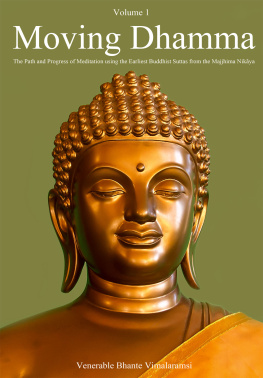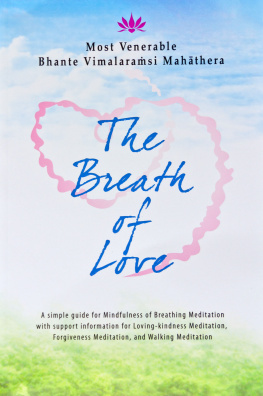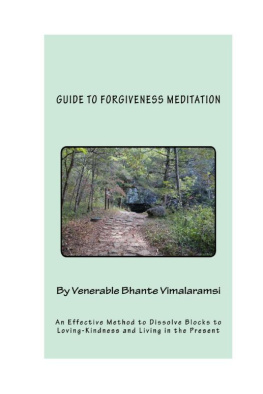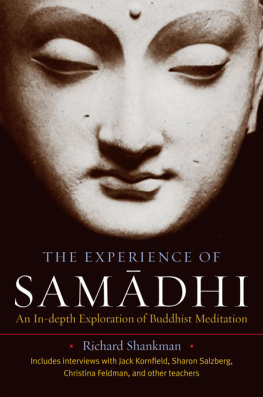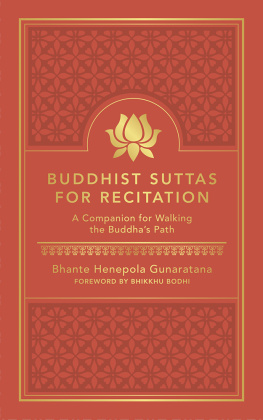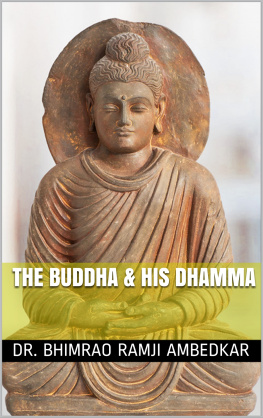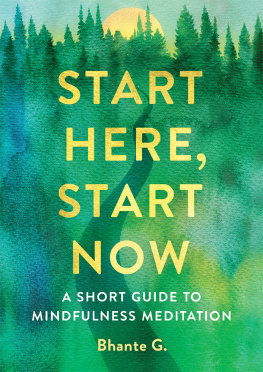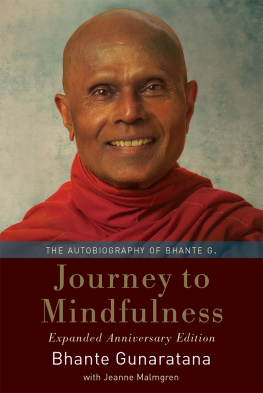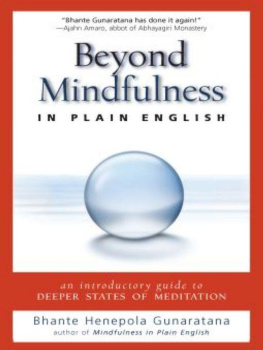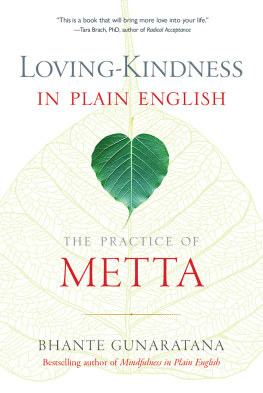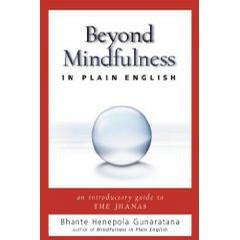Bhante Vimalaramsi - Moving Dhamma
Here you can read online Bhante Vimalaramsi - Moving Dhamma full text of the book (entire story) in english for free. Download pdf and epub, get meaning, cover and reviews about this ebook. year: 2013, publisher: dhammasukha.org, genre: Religion. Description of the work, (preface) as well as reviews are available. Best literature library LitArk.com created for fans of good reading and offers a wide selection of genres:
Romance novel
Science fiction
Adventure
Detective
Science
History
Home and family
Prose
Art
Politics
Computer
Non-fiction
Religion
Business
Children
Humor
Choose a favorite category and find really read worthwhile books. Enjoy immersion in the world of imagination, feel the emotions of the characters or learn something new for yourself, make an fascinating discovery.
- Book:Moving Dhamma
- Author:
- Publisher:dhammasukha.org
- Genre:
- Year:2013
- Rating:4 / 5
- Favourites:Add to favourites
- Your mark:
- 80
- 1
- 2
- 3
- 4
- 5
Moving Dhamma: summary, description and annotation
We offer to read an annotation, description, summary or preface (depends on what the author of the book "Moving Dhamma" wrote himself). If you haven't found the necessary information about the book — write in the comments, we will try to find it.
Moving Dhamma — read online for free the complete book (whole text) full work
Below is the text of the book, divided by pages. System saving the place of the last page read, allows you to conveniently read the book "Moving Dhamma" online for free, without having to search again every time where you left off. Put a bookmark, and you can go to the page where you finished reading at any time.
Font size:
Interval:
Bookmark:
Copyright 2012-2013 Bhante Vimalaramsi
All rights reserved.
ISBN 978-1-478-37306-3, 1-4783-7306-7
1st print: December 2012
2nd edited print: 6 September 2013
Other books by Bhante Vimalaramsi:
The Breath of Love
(2012)
Moving Dhamma, Volume 1
(2012)
The npnasati Sutta: A Practical Guide to Mindfulness of Breathing and Tranquil Wisdom Insight Meditation
(2006)
Dhamma Sukha Meditation Center
8218 County Road 204
Annapolis, MO 63620
U.S.A.
dhammasukha.org
Phone: +1 (573) 546-1214
For all present and future students of the Buddha and his teachings.
Strive on with Diligence.
The Buddha
This book of Dhamma Talks is an explanation of the earliest Buddhist Suttas available. By reading them and having practiced what is written there, I explain their meaning as it affects the meditation practice.
My life as a monk has been trying to find the earliest teachings that the Buddha gave to his Disciples and his Sagha of Monks 2600 years ago. I have spent the last 37 years of my life doing just this. I did many practices during that time, but it was in 1995 that I decided to drop all other practices and just use the Majjhima Nikya, which had just been translated and published by Bhikkhu Bodhi through Wisdom Publications, and to actually practice the meditation using only those as a guide and nothing else.
In a sense it was like remembering the experience of sitting under the rose apple tree after having been through 6 years of severe ascetic practice. I want to go back to what the Buddha was supposed to have said.
Amazingly, I found all of the Buddhas teachings contained right there. By that I mean the entire meditation instructions, the progress of insight, and the final goal and how that is attained.
You need nothing else but the Majjhima Nikya and the Sayutta Nikya; however, but you do need a guide to help explain these if you have not been down this path before.
I have changed some words in the translations to other words with definitions that I think are closer to the original meaning of the Pli and what I believe the Buddha really meant. For example, I use Collectedness vs. Concentration. Also in some places of the sutta I have put back in the older translation of the sutta that was left out so that you may understand the meaning better.
The reader, if using an electronic file reader like a Kindle or an iPad, may wish to turn on the text to speech function to listen to these talks, if this is available. This is the way they were given. These talks have been edited and have had some additional important material added, so they may not entirely match the talks posted on the Dhamma Sukha website.
The teachings of the Buddha are right here. I hope you find these teachings as interesting as I have.
Bhante Vimalaramsi
Abbot of the Dhamma Sukha Meditation Center
UIBDS United International Buddha Dhamma Society
July 15, 2012
David Johnson compiled and edited these talks and organized all of this material, while Christopher Farrant in Australia was our proofreader and editor who worked around the clock on perfecting the rough transcripts.
Sukha Sisso, the Dhamma Sukha webmaster in Texas, originally gathered all of the transcripts together with the audios, and did most of the early audio and transcript editing work. An additional mention may be made of the few people who did a couple of transcripts from home and submitted those to our webmaster.
Many thanks to Jens Trger who contributed the cover art, and who went through the manuscripts and put much effort into building eBooks of different formats. Also to Doug Kraft who helped us get this into a format that would be accepted by the publisher.
And of course to the Students who kept asking good questions so that many issues could be raised and answered.
Sutta translation Bhikkhu Bodhi 1995, 2001. Reprinted from The Middle Length Discourses of the Buddha: A Translation of the Majjhima Nikya ; and The Connected Discourses of the Buddha: A Translation of the Sayutta Nikya . With permission of Wisdom Publications, 199 Elm Street, Somerville, MA 02144 U.S.A., wisdompubs.org
I share the merit of this book with all my students, past and present, the editors and collaborators of this book, Bhikkhu Bodhi and Wisdom Publications, and with my parents who supported and raised me.
Bhante Vimalaramsi is an American Buddhist Monk of over 26 years. He started when he was 28 years old practicing meditation in California in the Burmese style of Vipassan . Gradually he gave up the material world and got on a plane for Thailand where he became a monk in 1986. He then went on to practice meditation intensively doing thirty days and three months retreats, and later even an eight months retreat plus a two years retreat in Burma under Sayadaw U Janaka.
At the end of this two years retreat his Burmese meditation teacher told him they had nothing left to do; he was now ready to go and teach on his own. Even with this high praise a feeling that there was something more to learn kept nagging at him.
He went on to Malaysia, and instead of Vipassan taught Mett (Loving-Kindness) Meditation. Bhante took the advice of an elder Sri Lankan monk by the name of Venerable Punnaji to use only the suttas for his referencing. So Bhante let go of the commonly used commentaries and obtained a copy of Bhikkhu Bodhi and Venerable Nyanamolis translation of the Majjhima Nikya. With that he headed off for a cave in Thailand where he spent three months practicing with the suttas as a guide and a cobra for company!
He started doing just what the suttas stated. He found out that in the suttas there was another step that appears to have been left out by later day teachers. The idea of Tranquilizing the bodily formations ( sankhra ) was included in the Satipahna Sutta yet had never been mentioned by other teachers Bhante studied with. (Check the chapter on MN-10, the Satipahna Sutta, in this book.)
When he added this relaxing step, the practice took on a completely new tone. The jhnas , as discussed in the suttas, became very real but with a slightly different flavor which Bhante calls a Tranquil Aware jhna . When he added the relax step the meditation completely changed and progress was very fast.
This book is the first book of a set of talks that Bhante gives on his ten days retreats, many of which may be watched directly on the Internet. Unlike many other teachers he actually reads from the sutta itself and then provides a commentary that explains what the Buddha meant. Every night the student hears a sutta that is geared to where they are in their daily progress on the retreat. Also, unlike other teachers, he invites questions from the audience and wants to make sure that everyone has understood the text as it is written.
Bhante uses and prefers the translations that are done by Bhikkhu Bodhi vs. other translations that exist. He also will replace certain words as he reads from the book with his own interpretation of what the word should really be. For example, whenever the word concentration is written in the suttas, Bhante will say collectedness which he believes is a better translation. So the reader should be aware that Bhante will, at times, substitute his own translation as he reads along so that the text may not fully agree with the printed book by Wisdom Publications.
The book is made up of transcripts of Bhantes talks. Some of the talks have introductions that were written by Phra Khantipalo, the editor of A Treasury of the Buddha's Words: Discourses From the Middle Collection , translated by Nyanamoli and edited by Phra Khantipalo, with notes by Phra Khantipalo. Then Bhante reads the sutta and comments on them. The actual sutta is bolded in the text of this book. Students ask questions periodically and he answers them, and then continues.
Next pageFont size:
Interval:
Bookmark:
Similar books «Moving Dhamma»
Look at similar books to Moving Dhamma. We have selected literature similar in name and meaning in the hope of providing readers with more options to find new, interesting, not yet read works.
Discussion, reviews of the book Moving Dhamma and just readers' own opinions. Leave your comments, write what you think about the work, its meaning or the main characters. Specify what exactly you liked and what you didn't like, and why you think so.

